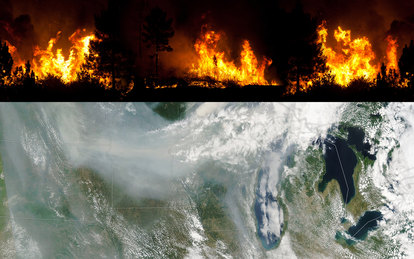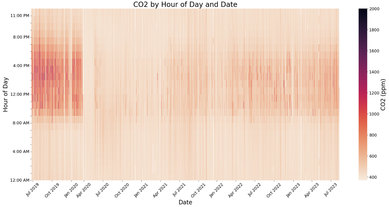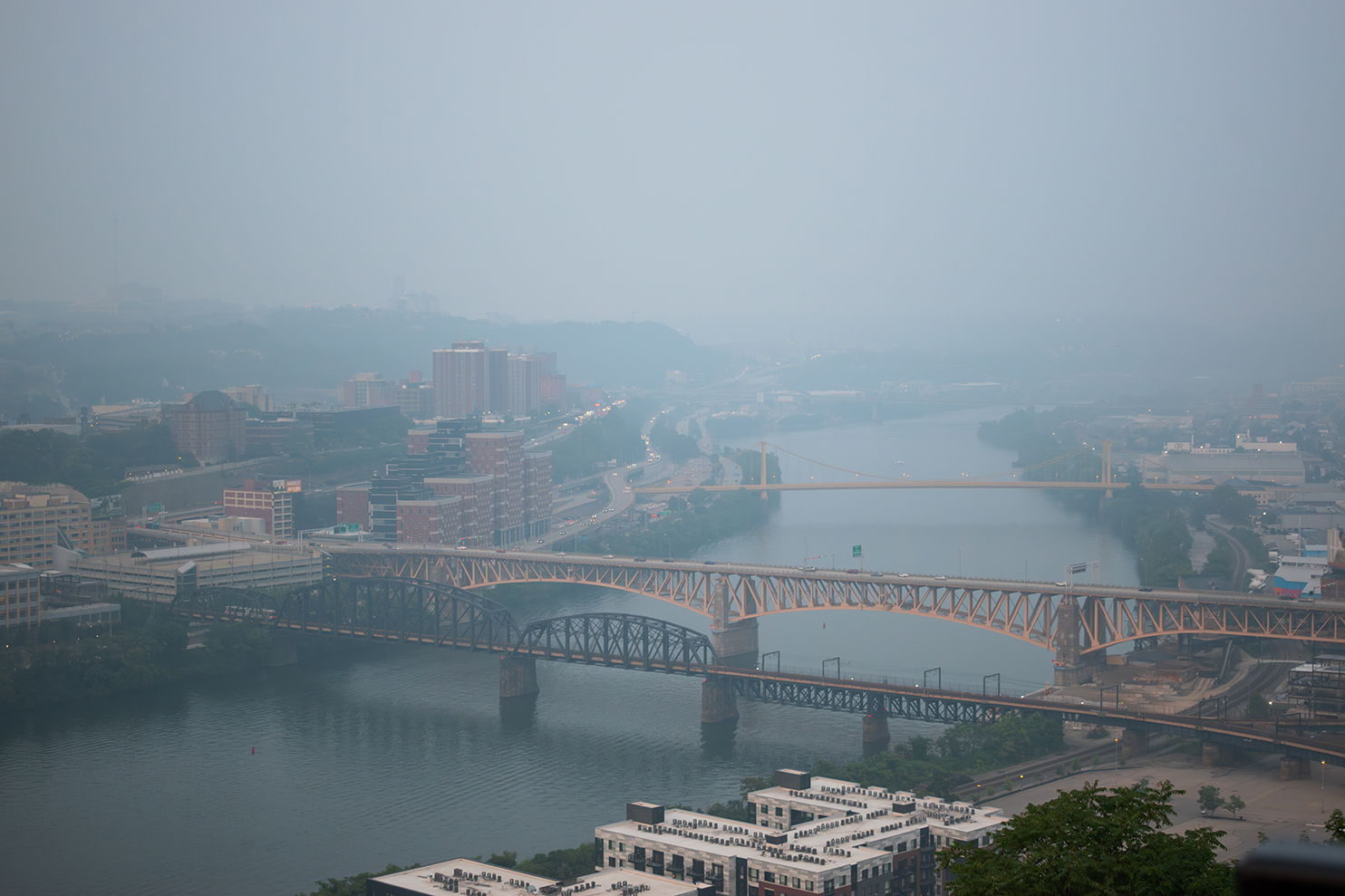The Smoke-Free Office: Lessons from SmithGroup's Sensor Lab

Satellite image showing wildfire smoke drifting over the Midwestern United States, June 2023
(NASA Earth Observatory, image by Lauren Dauphin)
In 2023, over 6,500 fires destroyed more than 45 million acres of Canadian forest. At times more than 1,000 fires were burning out of control, due to abnormally dry conditions exacerbated by record high temperatures. Besides the direct environmental destruction, secondary effects resulted in unprecedentedly widespread changes to air quality in Canada and the United States.
The excessive amounts of smoke from these megafires traveled well outside the Western areas of the country that have traditionally experienced these impacts annually. Recurring air quality warnings with hazy daytime visibility, burning odors, and breathing difficulties brought the topic to the forefront of public consciousness in the Midwestern and Eastern U.S. - areas definitely unaccustomed to sustained wildfire smoke.
While outdoor conditions this summer were dire, the detrimental effects on indoor air quality (IAQ) were not as widely reported. Understanding the impacts of poor indoor air quality on occupant health is key to recommending effective strategies to improve it. Critical to these interventions is a framework to evaluate their performance over time. SmithGroup’s internal Sensor Lab project, which includes the collection of IAQ data in our offices, allows us to conduct the detailed historical analysis required to put the recent events into perspective and make informed improvements to IAQ.
Health Concerns
Before delving into improving IAQ levels, it is critical to understand the detrimental effects of poor air quality. The unpleasant and dangerous outdoor air this summer was due to the presence of small soot particles contained within the wildfire smoke. Because their diameter is around 2.5 microns, these particles are members of a class of particulate matter commonly referred to as PM2.5. Due to their fine size, these particles can penetrate deeply into our lungs, causing heart problems, asthma, respiratory issues, and in some cases death. The National Resources Defense Council estimated the annual health costs due to PM2.5 in the U.S. are $820 billion, with $16 billion attributed to wildfires.
Indoor Air Effects
PM2.5 is commonly used as an air quality measurement for outside air. However, the air quality in our homes, offices, and other interior environments can also be evaluated for pollutants. As part of our Sensor Lab initiative, SmithGroup has been monitoring IAQ throughout our Ann Arbor office since 2019. We collect interior measurements for temperature, relative humidity, sound, light, volatile organic chemicals, carbon dioxide, and particulate matter across a sensor network. This data allows us to monitor recent trends as well as store it for historical analysis. To date, we have collected more than 62 million IEQ measurements at fifteen-minute intervals.
The chart below shows the daily indoor PM2.5 peaks over the past four years. While the overall peak of 48.44 mg/m3 occurred recently on June 8, 2023, it was not significantly higher than previous peaks, two of which were also greater than 40 mg/m3. (Levels up to 50 mg/m3 are rated as good air quality, with 50-100 being moderate; levels over 100 become increasingly unhealthy.) The chart below shows recurring spikes in PM2.5 over time, many of them in the summer months when wildfire smoke is a contributing factor.

Indoor PM2.5 values in SmithGroup's Ann Arbor Office since 2020 (summer months highlighted)
The interior PM2.5 values shown above are largely a result of outdoor conditions. To illustrate this point, the plot below shows both indoor and outdoor PM2.5 measures during the most intense period of wildfire smoke this summer. The peaks clearly indicate a correlation between the two environments. When outdoor values are elevated, indoor values are also higher. The delta between outdoor and indoor values indicates both the effectiveness of current filtration methods as well as potential room for improvement.

Indoor and Outdoor PM 2.5 values during summer of 2023 in Ann Arbor, MI
Unfortunately, episodic spikes in outdoor PM2.5 like those this summer are expected to continue and intensify due to changing climate conditions. Given this scenario, we need to mitigate the effects on our health by improving the conditions of our interior environments, where we spend 90% of our time.
Integrated Strategies to Improve IAQ
Data from our Sensor Lab initiative enables us to investigate strategic interventions and compare the results to established baseline levels. For example, prior to renovating our large conference rooms we frequently measured carbon dioxide (CO2) levels above 1,000 ppm. As part of the renovations, we improved the HVAC system by implementing demand-controlled ventilation, opening the economizer damper whenever CO2 rose above 800 ppm. As a result, measured CO2 levels have only exceeded 1,000 ppm once in the 3 years after renovations. This data-informed approach allows us to make similar interventions to reduce PM2.5 levels and to know how effective they are.

This color-coded tracking of large conference room CO2 levels shows the effective long-term performance of our HVAC improvements following implementation.
In the ongoing challenge to maintain high IAQ, many strategies that can improve CO2 levels (e.g. increasing outside-air exchange rates) may have detrimental IAQ impacts during a wildfire event with elevated exterior PM2.5 levels. However, an integrated approach to IAQ offers the opportunity for operational flexibility and provides operational resilience beyond IAQ. SmithGroup prefers to deploy an integrated approach beginning with passive strategies, followed by more sophisticated, technology-based solutions.
Improving the airtightness of a building enclosure reduces leakage of exterior air into the enclosure. This passive strategy provides benefits beyond wildfire season. Reduced infiltration can reduce HVAC loads as well as reduce the risk for unwanted moisture migrating through the enclosure, which mitigates uncontrolled condensation and resulting mold growth within the enclosure. More importantly during a wildfire event, a building with an airtight exterior reduces the particulate load on the recirculation filters often deployed to reduce indoor particulate counts.
Other building design strategies, such as the entry vestibules typically deployed in cold or hot/humid climates to reduce HVAC loads, can be deployed more universally to reduce unfiltered air exchanges that occur when people enter and leave. Similarly, buildings can be slightly pressurized to reduce uncontrolled infiltration of wildfire smoke. Improving airtightness of existing buildings can be challenging, especially when a full enclosure retrofit isn’t possible. Luckily, advancements in aerosolized air tightness products allow buildings to be retrofitted to aggressive airtightness levels in a matter of hours rather than days.
Installing IAQ sensors in a building allows for targeted and nuanced responses to wildfire events. Rather than a one-size-fits-all approach, and much like demand-controlled ventilation, appropriate sensoring allows for the effectiveness of strategies to be monitored in real time. This is especially true if buildings momentarily restrict outside air exchanges or economizer function, switching into recirculation mode. Although restricting outside air is an effective way to reduce the uptake of wildfire smoke, it is not a long-term strategy, as CO2 levels and other interior-sourced particulates may begin to exceed recommended levels. Regardless, real time monitoring is key to informing which strategies to deploy and for how long.
Much like pandemic-related recommendations, increased levels of filtration have a significant impact on reducing the impact of wildfire-sourced PM2.5. Improved filtration is recommended for outside air intake as well as for recirculated air. In some cases, buildings may elect to install HEPA filtration; it is recommended that this be temporary, however, as HEPA filtration consumes more energy and is not needed most of the time for most environments.
If sensor data suggests that a particular room is especially problematic, a local recirculated filter is recommended. In wildfire-prone regions of the country, building owners or occupants may elect to add a second intake plenum with low-pressure-drop HEPA filtration and automated switchover controls. This allows for a “Wildfire Mode” to engage automatically when outside air particulates exceed safe values and then return automatically to standard operation when conditions improve.
As part of our commitment to creating healthier work environments for ourselves and our clients, we realize that commitment alone is not enough for maintaining IAQ. We need deeper, more robust data to establish baselines, monitor performance, and inform adjustments and adaptations over time. The ultimate goal of SmithGroup’s Sensor Lab isn’t to create a smart office – it’s to design and maintain a healthier office. With unprecedented air quality events predicted to happen more frequently, how effectively we do this takes on added importance and urgency.

